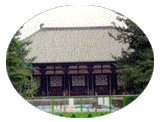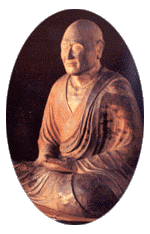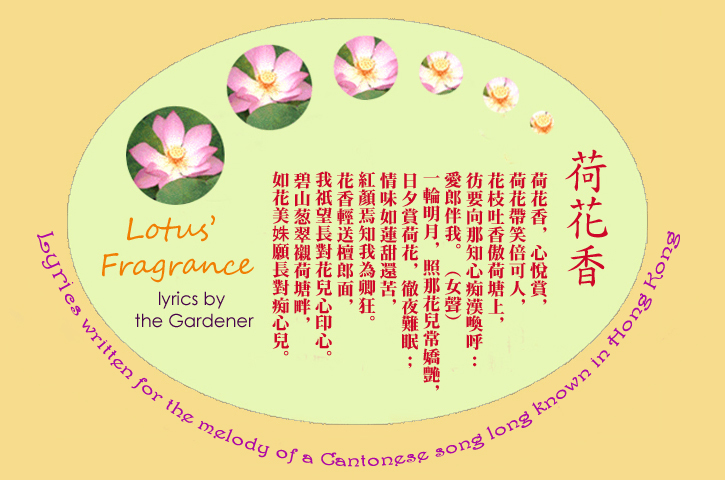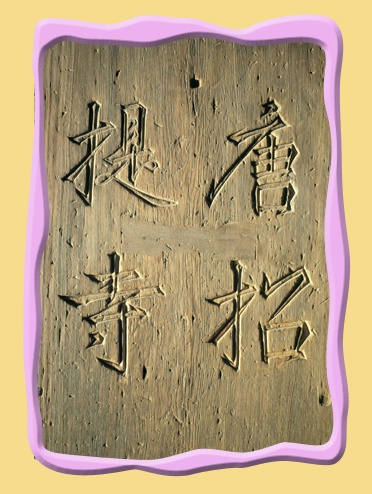LOTUS' FRAGRANCE
VIEWING LOTUS IN TOSHODAIJI MONASTERY, NARA CITY, July 2000 + VIEWING JIANZHEN STATUE, May 2009

| Toshodaiji Buddhist monastery in Nara was founded by the Chinese Buddhist monk Ganjin (Jianzhen) in 759.
Ganjin was invited to Japan by the Japanese Emperor Shomu.
|
The hollow dry lacquer statue of monk Ganjin (688-763) housed in Toshodaiji.
Measuring 80 cm in height and sculptured around 763,
this statue is made of layers of hemp cloth soaked with lacquer.
|
|

Side view of the Main Hall (金堂) of Toshodaiji in May 2010 after renovation
|
||

Admission ticket of 2010 showing the Main Hall (金堂)
|
||

孫文蓮 "Sun Wen Lotus" in Toshodaiji, growing in a pot
|
||
Interesting Facts of the Lotus
1. Lotuses  and waterlilies
and waterlilies  are different plants. Although both are in the family Nymphaeaceae, the lotus belongs
to the genus Nelumbo, while waterlilies belong to the genus Nymphaea.
are different plants. Although both are in the family Nymphaeaceae, the lotus belongs
to the genus Nelumbo, while waterlilies belong to the genus Nymphaea.
2. The lotus is noted for its large flowers: some varieties have flowers with diameter up to 28 cm (11 inches).
3. Only two species exist in the world today. "Nelumbo nucifera, with pink or white flowers, is distributed
in Asia and Oceania. . . . Nelumbo lutea, with yellow flowers, is distributed in [North and South America]."
(Flowering Lotus of China, p. 6). Today in China there are over 200 cultivated varieties (cultivars)
of lotus.
4. Lotus seeds can be dormant for some 1,000 years or more, and still capable of germinating into blossoming plants.
"Dr Sun Yat-sen brought with him 4 ancient lotus seeds found in Liaodong Peninsula [in northeast China], when he went
to Japan in 1919, and presented them to Mr Takashi Tanaka [Sun's landlord] as a token of their friendship. The seeds were
germinated by [the Japanese lotus expert] Dr Ichiroh Ohga and the plants bloomed in 1930. They were named 'Sun Wen' lotus after Dr Sun Yat-sen's original
name." (Flowering Lotus of China, p. 5)
5. For the Chinese, lotus is viewable for its prettiness and edible in various ways. Lotus seeds, leaves and rhizomes are all
food items. Lotus parts carry matrimonial and love connotations for the Chinese, although the lotus is also associated with
Buddhism.
* * *

Asahi Hōsō Kabushiki Kaisha 朝日放送株式会社. Ganjin Wajō zō satogaeri nijūshūnen ten 鑑真和上像里帰り二十周年展. [Japan]: Asahi Hōsō Kabushiki Kaisha, [1999]
A commemorative book on the home-coming visit (exhibition) of the statue of Ganjin
from Japan to China in 1980.
Kokuhō no bi = National treasures of Japan 国宝の美. 01[sōkan 創刊] (May 2009).
This inaugural issue is on the hollow dry lacquer statues of the 8th century, including an illustrated step-by-step description of the technique
of making dry lacquer statues on p. 20-21.
Moran, Sherwood F. "Ashura, a dry-lacquer statue of the Nara period." Artibus Asiae 27 (1964): 99-133.
A detailed account of the hollow dry lacquer statue-making method.
Wang Qichao and Zhang Xingyan 王其超 and 張行言. Zhongguo he hua pin zhong tu zhi 中國荷花品種圖誌. Taibei: Shu xing chu ban she, 1994.
Zou Xiuwen, Zhao Xiaorui and Jin Xiaobai 邹秀文, 赵效锐 and 靳晓白. Zhongguo he hua = Flowering Lotus of China 中国荷花. Beijing: Jindun Publishing House, 1997.
Text in Chinese and English.
* * *
The Chinese term on the right is the ancient name of lotus,
pronounced as "han dan" in putonghua or Mandarin
and as "haam daam" in Cantonese.







